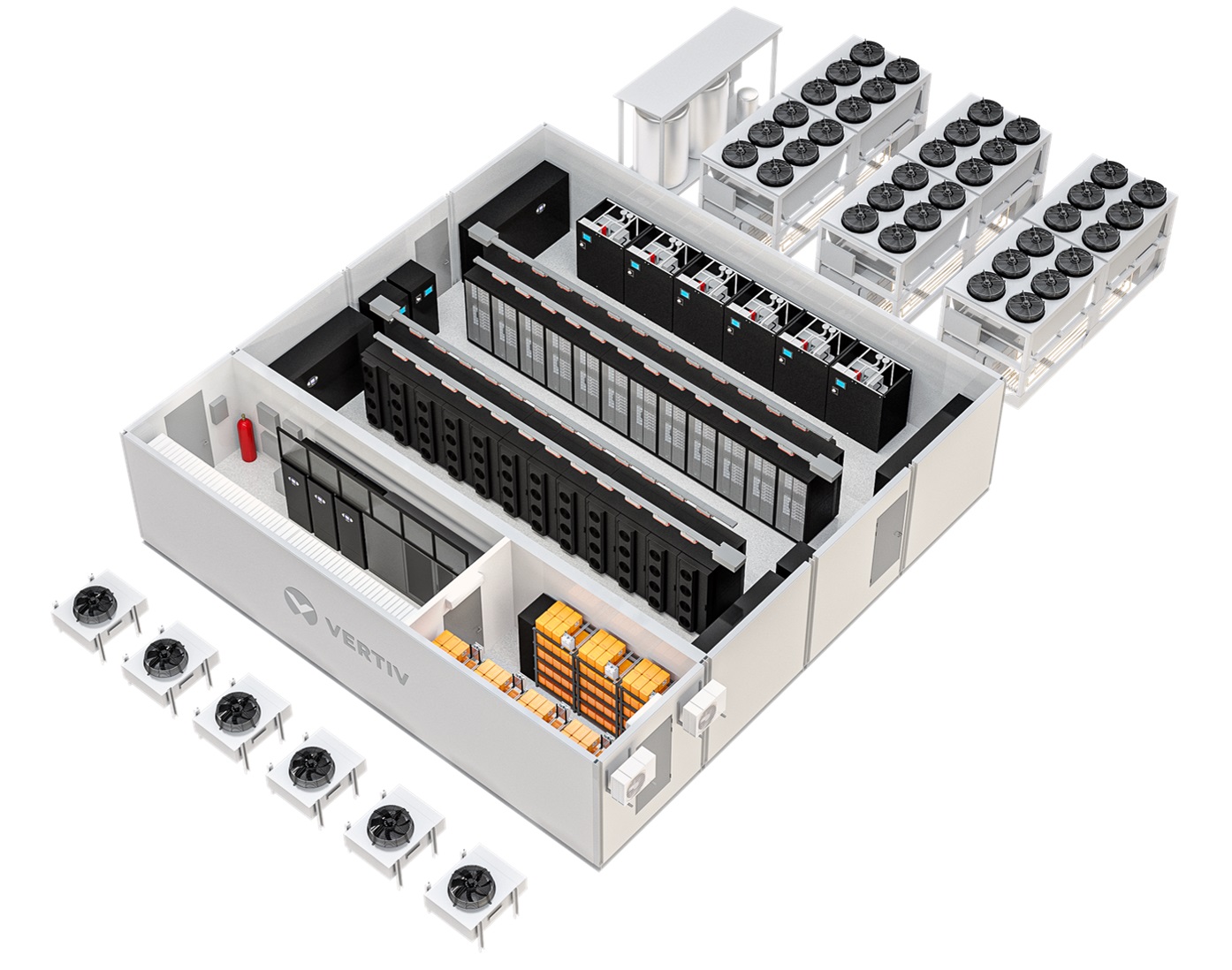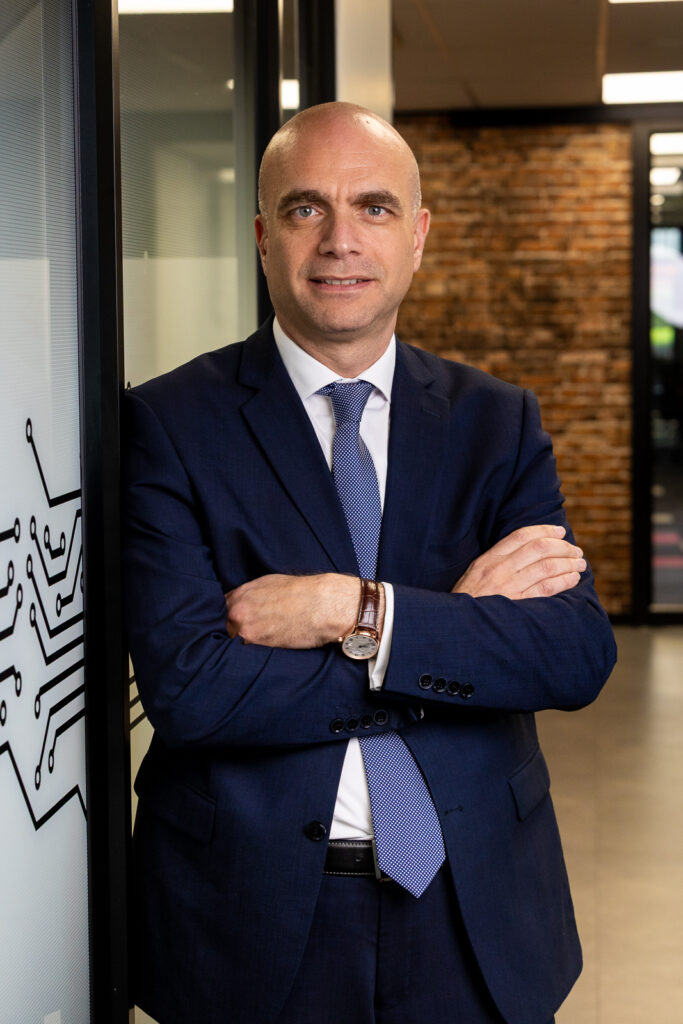Tech Interviews
Vertiv Expands Liebert GXT5 Line with New Lithium-Ion UPS Models

Integrator Media had an exclusive interview with Nassif Yazbeck, Channel Sales Director – METCA, Vertiv
Introduce this technology – Vertiv Liebert GXT5 Lithium-Ion UPS system – what it is all about?
Vertiv recently introduced the extension of the Vertiv Liebert GXT5 Lithium-Ion double-conversion, on-line uninterruptible power supply (UPS) system for 5kVA-10kVA Global Voltage (GV) (200V-240V; Default 230V) applications. This expansion of the Liebert GXT5 Lithium-Ion line to 10kVA (from 1-3kVA) further rounds out the Vertiv portfolio of lithium-ion UPS systems and solutions for the edge of the network. Lithium-ion technology delivers two to three times the useful life of lead-acid batteries along with a lower total cost of ownership, making the Liebert GXT5 Lithium-Ion online UPS ideally suited for network and server rooms, and other mission-critical edge applications.
How does the Vertiv Liebert GXT5 Lithium-Ion UPS system for 5kVA-10kVA applications address the specific needs of data centers?
The Liebert GXT5 Lithium-Ion models are designed for the smaller spaces typical of the network edge, with a convertible rack/tower design and only a 3U (5kVA to 10kVA UPS) rack height. These systems include an integrated maintenance bypass cabinet preserving additional rack U-space. All Liebert GXT5 Lithium-Ion UPS systems come with a five-year limited warranty. Here are their key features that make them ideal for network edge:
- • High-Performance Battery Technology with Lithium-ion batteries lasting up to three times longer than VRLA batteries. They offer 20 to 50 percent more runtime compared to VRLA batteries, making them ideal for mission-critical applications.
- • Space-Saving Design as the Liebert GXT5 models are designed for smaller spaces typical of the network edge.
- • Lower Total Cost of Ownership (TCO) with up to a 50% lower TCO compared to traditional UPS systems.
- • Intellislot and Network Connectivity as the UPS includes an Intellislot with a pre-installed network card which allows for remote monitoring, management, and alerts, enhancing overall reliability and efficiency
With lithium-ion batteries lasting eight to ten years, compared to the three to five years for VRLA batteries, how does this impact the total cost of ownership and maintenance schedules for data center operators?
The longer lifespan of lithium-ion batteries results in lower replacement costs over time. Data center operators can avoid frequent battery replacements, reducing the overall TCO. Additionally, lithium-ion batteries have lower maintenance costs due to their reliability and reduced need for regular maintenance activities.
In addition, with VRLA batteries, data center operators must plan for more frequent replacements, which can disrupt operations and require additional labor. In contrast, the extended lifespan of lithium-ion batteries allows for longer intervals between replacements. Maintenance schedules can be adjusted to align with the longer battery life, resulting in fewer service interruptions and reduced operational downtime.
Fewer battery replacements translate to less waste and a reduced environmental footprint. Proper disposal and recycling of batteries are essential, but the overall impact is still lower with lithium-ion technology.
What role does the Liebert GXT5 Lithium-Ion UPS system play in enhancing the sustainability and energy efficiency of data centers?
Liebert GXT5 Lithium-Ion UPS helps with the following to enhance the energy efficiency of data centers:
Operating Temperatures:
The Liebert GXT5 Lithium-Ion UPS is designed to perform even in higher operating temperatures. Unlike traditional valve-regulated lead-acid (VRLA) batteries, which can be sensitive to temperature fluctuations, lithium-ion batteries demonstrate better performance and reliability across a wider temperature range. This resilience allows data centers and edge sites to operate efficiently in various environmental conditions, including those at the network edge where temperature control may be challenging.
Battery Life Expectancy:
One of the standout features of the GXT5 UPS is its longer battery life expectancy. Lithium-ion batteries typically last up to three times longer than VRLA batteries. The extended lifespan translates to fewer battery replacements over the life of the UPS, reducing operational disruptions and maintenance costs. Data center operators benefit from lower total cost of ownership (TCO) due to reduced replacement expenses.
Energy Efficiency:
The Liebert GXT5 Lithium-Ion UPS offers high efficiency in both online mode and Active ECO mode. This efficiency minimizes energy waste and contributes to overall energy savings. By using lithium-ion technology, data centers can optimize power protection while maintaining a focus on sustainability.
How is Vertiv positioning itself to capitalize on the expected rapid growth of lithium-ion battery adoption in data centers?
The Liebert GXT5 Lithium-Ion UPS offers compactness, versatility, and low-maintenance, presenting an efficient solution perfectly suited for remote sites with minimal onsite technical support. With this expanded offering, Vertiv is poised to capitalize on the expected rapid growth of lithium-ion batteries. Vertiv recognizes the increasing importance of managing energy consumption and reducing carbon footprints in data centers. As data centers are estimated to be responsible for up to 3% of global electricity consumption (projected to touch 4% by 2030), governments are scrutinizing their resource usage. Vertiv’s experts expect increasing regulatory oversight in the near future, prompting the industry to self-monitor and adopt environmentally friendly practices.
Lithium-ion batteries offer several advantages over traditional lead-acid batteries, including greater life expectancy, more runtime (for a given battery power density), quicker recharge time, and better performance at higher temperatures.
Tech Interviews
INCEPTION SHOWCASES THEIR LATEST INNOVATION AT GITEX GLOBAL 2025

Attributed to Vishal Mishra, Director of AI and Software Engineering, Inception, a G42 company
Inception’s presence at GITEX this year focused on bringing enterprise-ready AI solutions to life. Could you walk us through the key innovations being showcased and what makes them stand out in the regional AI landscape?
At GITEX Global 2025, under the theme ‘Authentic Intelligence. Real Impact.’, we showcased our suite of domain-specific and sector-agnostic AI products that are transforming how organizations operate and make decisions. This included (In)Sight, (In)Alpha, (In)Procurement, (In)Business Human Capital, (In)Business Productivity, (In)Business Process, (In)Business Customer Experience, and (In)Media, with a selection of them being demonstrated. These products showed how Inception is helping governments and organizations accelerate transformation, improve efficiency, and generate measurable progress across sectors.
We are also announced a series of strategic partnerships to strengthen our capabilities and global reach and reflect Inception’s commitment to bringing authentic intelligence to life, driving enterprise transformation, and contributing to the UAE’s vision of becoming an AI-native nation.
What distinguishes these innovations in the regional AI landscape is their enterprise readiness and practical impact. Each product has been designed to integrate seamlessly into real operational environments, enabling businesses and government entities to automate complex processes, enhance decision-making, and drive value creation responsibly and transparently. Our focus is on delivering AI that is explainable, compliant, and aligned with national priorities for sustainable digital transformation.
Our presence and partnerships reflect Inception’s commitment to bringing authentic intelligence to life, driving enterprise transformation, and contributing to the UAE’s vision of becoming an AI-native nation.
Inception has evolved rapidly from an AI research hub to a product-first company. Can you give us an overview of your current AI-native products and how they are enabling organizations to automate complex workflows and make smarter decisions?
Inception’s transition from a research-driven institute to a product-first company reflects a clear focus on building practical, enterprise-ready AI that delivers measurable outcomes. Our current portfolio of AI-native products is designed to address specific business and leadership challenges while enabling enterprises to automate complex workflows, generate real-time insights, and make data-driven decisions with confidence.
Our suite of products spans multiple layers of enterprise operations:
- (In)Sight: An AI-powered product for top executives that transforms leadership collaboration by automating meeting workflows, surfacing real-time insights, and integrating seamlessly with Microsoft 365 to drive faster, more confident decision-making.
- (In)Genius: A sophisticated AI-powered insight generation and analysis system designed for automated business strategy research, validation, and reporting
- (In)Alpha: An AI-driven intelligence product that uncovers hidden patterns and insights from vast volumes of unstructured data, enabling more informed investment decisions while reducing biases
- (In)Procurement: An AI-powered platform that transforms supplier discovery, contract management, and sourcing processes with automated workflows and built-in regulatory checks that guarantee 100% compliance
- (In)Media: A next-generation AI media intelligence platform that detects, analyzes, and responds to harmful or misleading narratives in real time.
- (In)Business Process: A no-code AI automation platform that lets enterprises design, deploy, and orchestrate intelligent agents to streamline complex workflows, integrate with existing systems, and ensure secure, scalable process optimization
- (In)Business Productivity: A no-code platform designed to transform the way employees handle daily tasks by integrating speed, intelligence, and automation through a suite of prebuilt, AI-powered workflows that simplify and accelerate work processes
- (In)Business Customer Experience: An AI-powered platform that helps businesses deliver faster, more personalized support across chat, voice, avatar, and web channels through virtual agents and intelligent tools that empower human agents.
Each of these products represent a step toward operationalizing AI across every level of the enterprise. They embody Inception’s mission to leverage authentic intelligence to bring about real impact by enhancing quality decision, operational efficiency, and organizational agility.
Agentic AI is becoming a major theme in enterprise transformation. How does Inception define agentic AI, and what makes it different from traditional chatbots or rule-based systems?
Traditional chatbots or rule-based systems handle tasks by following instructions. They don’t have the ability to interpret, adapt, or anticipate. Instead, they rely on pre-programmed scripts to respond to isolated inputs. Agentic AI, on the other hand, solves problems. It doesn’t wait to be told what to do; it interprets intent, maintains memory across interactions, adjusts to dynamic input, and collaborates with other agents and humans to reach outcomes. It’s essentially an assistant that doesn’t just follow commands but proactively navigates the complexities of enterprise operations.
At Inception, we have a range of products that deploy Agentic AI across different business functions within an organization. (In)Procurement does more than automate contract workflows. It identifies high-performing, sustainable suppliers, accelerates sourcing-to-award cycles, ensures compliance, and drives measurable savings. Our (In)Business Productivity and (In)Business Process products empower teams to deploy no-code AI agents that coordinate workflows, surface knowledge, and make intelligent decisions often faster, more accurately, and at greater scale than human-led systems.
How do you see the adoption of technologies like Agentic AI, sovereign cloud, and domain-specific models influencing the UAE’s innovation and competitiveness over the next few years?
The UAE is entering a new phase of digital maturity where AI is no longer a supporting tool but a national capability. The convergence of Agentic AI, sovereign cloud infrastructure, and domain-specific models is accelerating that transition, creating a foundation for innovation that is secure, scalable, and deeply contextual.
Agentic AI brings autonomy and adaptability to enterprise systems, enabling them to learn and act with minimal intervention. When these systems are deployed within sovereign cloud environments, they operate with trusted national infrastructure that ensures data privacy, compliance, and resilience. Domain-specific models then take this one step further by embedding specialized knowledge that reflects the realities of that respective domain.
By combining Agentic AI capabilities with sovereign infrastructure and purpose-built models, the UAE is demonstrating how nations can build sustainable digital ecosystems that enhance competitiveness, drive productivity, and unlock new opportunities for growth. Inception’s mission is to ensure that this intelligence is not abstract but actionable, bridging the gap between research and real-world impact.
Tech Interviews
From Reactive to Predictive: How AI is Revolutionizing Cybersecurity in the Middle East

Exclusive Interview with Assad Arabi, Regional Managing Director Africa, Mediterranean and CIS, Trend Micro

What are your impressions of GITEX this year?
GITEX has always been an incredible platform, but this year feels different, there’s more energy, more excitement, and a clear focus on meaningful business conversations. The engagement level is impressive, and it’s great to see the region’s digital ecosystem evolving so rapidly.
What is the current state of cybersecurity in the Middle East and Africa?
It’s getting increasingly complex. We’re seeing more AI-driven, sophisticated cyberattacks that are harder to detect and mitigate. Last year alone, Trend Micro detected around 1.35 billion cyber threats in MEA , a staggering figure considering even one major attack can disrupt entire organisation. Globally, cybercrime is projected to cost around USD 10 trillion, which is an enormous economic loss.
This growing threat landscape demands a new approach. Instead of reacting after attacks occur, we’re shifting to a predictive cybersecurity model anticipating threats before they strike. By identifying patterns and alerting organisations in advance, we’re helping them safeguard critical data and infrastructure proactively.
What key innovations is Trend Micro showcasing at GITEX 2025?
This year is special for us. Our flagship Trend Vision One platform, known as the world’s most comprehensive cybersecurity platform, continues to evolve. It integrates multiple security layers from endpoint and server to cloud, network , data, email, IoT, and OT security — into one unified ecosystem.
The latest innovation we’re showcasing is our Agentic SIEM solution, launched just last month. Among the first of its kind globally, it leverages AI to automate rule creation, configurations, and response actions. This will revolutionise how SOC teams operate paving the way for fully autonomous security operations powered by AI.
What emerging trends are shaping 2025?
One of the most concerning trends is the rise of AI-driven threats, especially deepfakes. Attackers can now replicate voices, faces, and data to create what we call “malicious digital twins.” Imagine a video that looks and sounds exactly like you, used to deceive others , it’s a new frontier of cyber risk. We’re actively developing tools to detect and neutralise these threats before they cause harm.
How is Trend Micro leveraging AI to stay ahead of evolving attacks?
AI is central to everything we do. We’ve developed systems that not only detect but quantify cyber risk. For example, organisations receive a numerical cybersecurity score , say, 67 today and 70 tomorrow ,helping them see risk fluctuations in real time and take corrective action.
We’re also creating cybersecurity digital twins, replicating clients’ digital cyber security environment on our platform to safely simulate attacks and test resilience. This enables predictive defence and faster response.
What defines the next generation of cybersecurity?
The next era of cybersecurity will be defined by intelligence and foresight. Having advanced tools isn’t enough; you need actionable threat intelligence. It provides visibility into what’s happening, what could happen, and where your vulnerabilities lie. This shifts cybersecurity from reactive to truly preventive.
How is AI transforming the way organisations predict threats?
At Trend Micro, AI is embedded across our entire ecosystem from endpoint and network protection to cloud, OT, and IoT security. We collect native telemetry data into a central data lake and apply AI models and threat intelligence to correlate anomalies and detect hidden attacks.
Our proprietary Cybertron large language model (LLM) is a breakthrough. It analyses threats contextually, offering insights tailored to each organisation rather than generic alerts. It empowers security teams to identify, prevent, and neutralize threats before they materialize. This advanced level of intelligence was unimaginable just two years ago, and it’s redefining how cybersecurity protection should be perceived .
What are the biggest challenges organisations face in a cloud-native environment?
The biggest hurdle is mindset. Many organisations still use traditional security methods for cloud environments and that simply doesn’t work. Trend Micro offers a complete cloud-native security portfolio covering applications, workloads, containers, storage, and configuration. Our attack surface and exposure management tools continuously assess cloud posture, identify risks, and alert teams before vulnerabilities are exploited.
What impact has the Trend Vision One AI Companion delivered?
The AI Companion acts like our version of ChatGPT for cybersecurity analysts. They can ask questions such as “What does this alert mean?” or “What should I do next?” and receive instant, actionable guidance or even have the system perform those actions automatically. This has dramatically reduced response times and helped close the cybersecurity skills gap, enabling junior analysts to perform at senior levels.
What sets Trend Micro apart from other cybersecurity companies?
As a Japanese company, precision and commitment are part of our DNA. For over 37 years, cybersecurity has been our singular focus. If we enter a segment, it’s because we intend to lead it.
Our leadership is consistently recognised by Gartner, Forrester, and IDC across multiple domains from endpoint and network to IoT and attack surface management. What truly differentiates us is our natively integrated ecosystem, which simplifies management, enhances visibility, increase the protection , and strengthens customer confidence.
Tech Interviews
AI is Not an Add-On, But an Enabler!

In a brief interview at GITEX, Technology Integrator speaks with expert Shivdayal Charan, Director of Middle East at Torry Harris Integration Solutions on how the company is enabling digital transformation across industries through modernization, AI enablement, and connected digital ecosystems.

1. Could you give us an overview of Torry Harris, what the company does, and its core areas of expertise?
At Torry Harris, our purpose is to make digital transformation real – grounded in business logic, scalable through technology, and outcome-driven. For over two decades, we have helped enterprises rebuild the connective tissue of their businesses – modernizing legacy systems, integrating data, and creating digital ecosystems that scale.
Our expertise is at the intersection of API-led integration, cloud modernization, and digital ecosystem enablement – foundations that turn technology landscapes into agile, interoperable networks. From telecom and finance to logistics and government, we help enterprises move beyond isolated systems to unified, intelligent architectures that enable real-time collaboration and innovation.
We often say that we don’t just integrate systems; we integrate with intent. Because true modernization isn’t about technology alone – it’s about creating coherence between business vision and digital execution. That’s what allows enterprises to innovate with confidence, move at market speed, and build resilience.
Headquartered in the US, with regional offices in Dubai and Riyadh, we’re deeply aligned with the Middle East’s digital transformation ambitions – simplifying digital complexities and helping public and private enterprises translate strategy into sustained progress.
2. What is one of the company’s latest core offerings?
Our flagship platform, SMART Souq, is where AI meets ecosystem thinking. SMART Souq is an AI-powered marketplace platform that enables organizations to design and scale digital ecosystems around themselves. It connects suppliers, partners, and customers into a single fabric where data, APIs, and services flow naturally.
The platform supports hybrid engagement models (such as B2B2C and G2B2C) and enables organizations to monetize APIs, data, and services as part of a larger digital value chain. Its embedded 4Sight intelligence layer combines personalization, conversational AI, and predictive insights, while its low-code framework allows business teams to configure user journeys, onboarding flows, and monetization models without heavy engineering lift.
Today, speed defines relevance. Enterprises can’t afford to prototype for months; they must launch at market pace and refine in motion. SMART Souq enables exactly that – moving from concept to deployment in weeks, not quarters.
Take a regional bank, for instance. With SMART Souq, it can evolve from being a service provider to an ecosystem hub – integrating insurance, auto finance, mortgages, and lifestyle services – all under one digital roof. What was once a transaction becomes an ongoing relationship, renewed every day through context and connection. That’s the future of marketplaces – less about transactions, more about context.
3. Could you elaborate on the key solutions you are showcasing at GITEX this year and how they are helping enterprises accelerate their digital transformation journeys?
This year at GITEX, we are prioritizing what we call the three levers of digital momentum – modernization, intelligent automation, and connected ecosystems.
Modernization is where agility begins – taking what’s already working and making it cloud and AI-ready. It’s not about starting over; it’s about starting smarter. Done right, modernization renews the core, embeds intelligence, and creates the conditions for speed and scale. It’s how banks cut release cycles, how cities deliver digital services, and how governments move from efficiency to experience.
Intelligent automation builds on that core. Through APIs and integration frameworks, we create a digital nervous system – a fabric where data, workflows, and partners move securely and in sync. When systems speak a common language, business starts to move as one.
And when that foundation is in place, ecosystems begin taking shape. SMART Souq turns these internal capabilities into external opportunities – enabling enterprises to co-create and monetize APIs, data, and services through a larger value network.
Modernize the core – Connect the fabric – Monetize the flow. That’s how transformation stops being a plan and becomes a pattern – one that organizations can repeat, refine, and scale.
3. Artificial Intelligence is a major focus across industries today. How is Torry Harris integrating AI into its offerings, and what value does this bring to your clients?
AI has moved from experimentation to expectation. The real question now is – how do enterprises embed it meaningfully, not just visibly?
At Torry Harris, AI is not an add-on but an enabler that runs through our entire portfolio. Our AI Factory helps enterprises industrialize adoption – combining automation, data pipelines, and decision intelligence into a single operational fabric. The goal is simple: measurable outcomes, not model counts. Efficiency that shows up in metrics, prediction that shows up in decisions, and personalization that enhances experience.
Our 4Sight analytics engine turns raw data into foresight. It learns from operational patterns, customer behavior, and market signals – helping enterprises anticipate demand instead of react. You can see this clearly in SMART Souq – its AI engine continuously learns from interactions, predicting needs and optimizing engagement in real time. In real estate, it might infer buyer intent; in logistics, it might optimize partner routes. AI here doesn’t replace human intuition but augments it.
And through our Agentic AI Services, we extend that intelligence across the enterprise, embedding it into operations, testing, integration, and decision systems. The result is AI that’s pragmatic, governed, and aligned to business rhythm, not hype cycles.
4. Could you share an example of a recent project where Torry Harris helped an enterprise modernize or integrate its systems, and what measurable impact it delivered?
A recent example I can reference comes from our work with NBQ – a leading regional bank that needed modernize its integration landscape for agility and scale – without dismantling what already worked.
We implemented a secure API management layer that unified systems and created real-time data exchange across the bank’s ecosystem. The results were tangible – 45% improvement in operational efficiency, 30% reduction in integration costs, and partner onboarding time cut from three days to one. More importantly, NBQ could launch new digital services 40% faster – a critical edge in a market where speed defines customer experience.
But the real change wasn’t technical; it was behavioral. NBQ stopped managing systems and began orchestrating outcomes. Teams moved faster, experiments carried less risk, and innovation turned from being occasional to repeatable.
-

 Tech News1 year ago
Tech News1 year agoDenodo Bolsters Executive Team by Hiring Christophe Culine as its Chief Revenue Officer
-

 VAR7 months ago
VAR7 months agoMicrosoft Launches New Surface Copilot+ PCs for Business
-

 Tech Interviews2 years ago
Tech Interviews2 years agoNavigating the Cybersecurity Landscape in Hybrid Work Environments
-

 Tech News4 months ago
Tech News4 months agoNothing Launches flagship Nothing Phone (3) and Headphone (1) in theme with the Iconic Museum of the Future in Dubai
-

 Tech News2 years ago
Tech News2 years agoBrighton College Abu Dhabi and Brighton College Al Ain Donate 954 IT Devices in Support of ‘Donate Your Own Device’ Campaign
-

 Editorial11 months ago
Editorial11 months agoCelebrating UAE National Day: A Legacy of Leadership and Technological Innovation
-

 VAR1 year ago
VAR1 year agoSamsung Galaxy Z Fold6 vs Google Pixel 9 Pro Fold: Clash Of The Folding Phenoms
-

 Cover Story8 months ago
Cover Story8 months agoUnifonic Leading the Future of AI-Driven Customer Engagement













